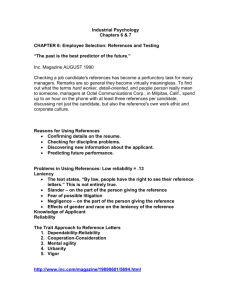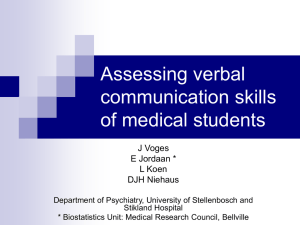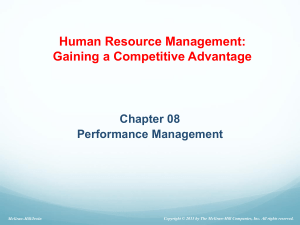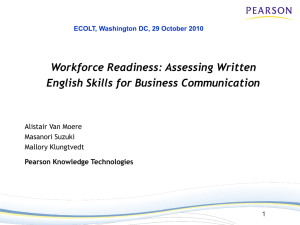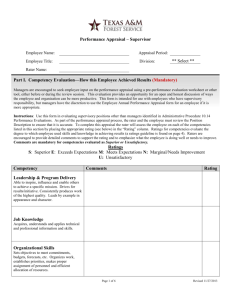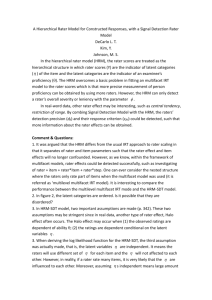Raters and Rating Scales in Language Testing
advertisement
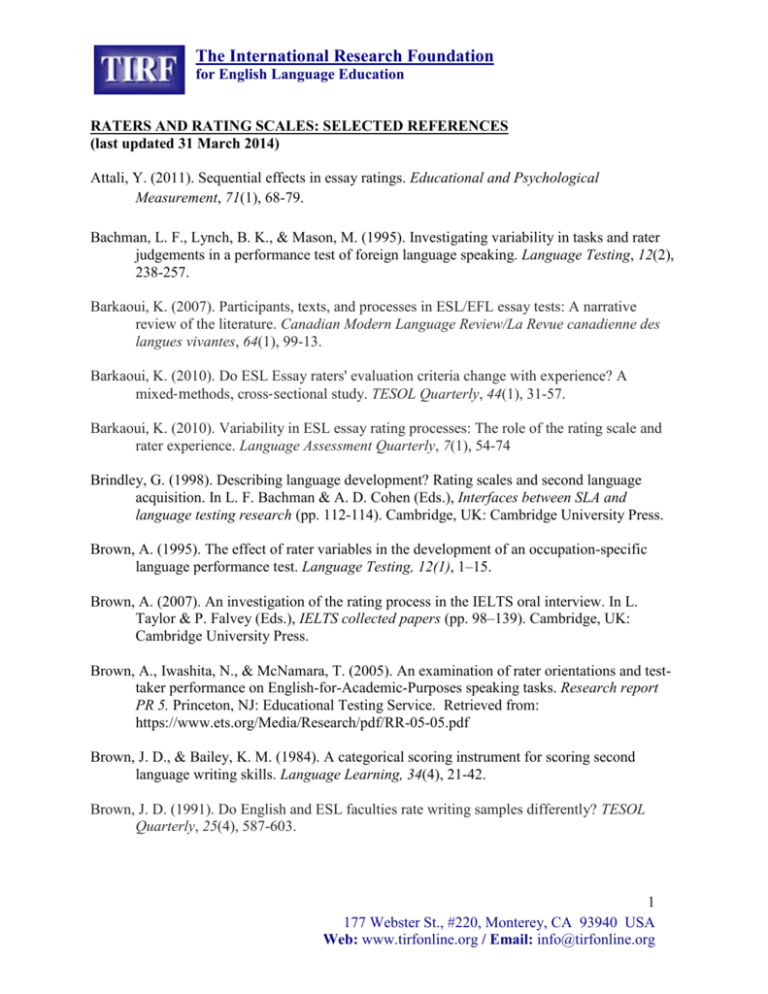
The International Research Foundation for English Language Education RATERS AND RATING SCALES: SELECTED REFERENCES (last updated 31 March 2014) Attali, Y. (2011). Sequential effects in essay ratings. Educational and Psychological Measurement, 71(1), 68-79. Bachman, L. F., Lynch, B. K., & Mason, M. (1995). Investigating variability in tasks and rater judgements in a performance test of foreign language speaking. Language Testing, 12(2), 238-257. Barkaoui, K. (2007). Participants, texts, and processes in ESL/EFL essay tests: A narrative review of the literature. Canadian Modern Language Review/La Revue canadienne des langues vivantes, 64(1), 99-13. Barkaoui, K. (2010). Do ESL Essay raters' evaluation criteria change with experience? A mixed‐methods, cross‐sectional study. TESOL Quarterly, 44(1), 31-57. Barkaoui, K. (2010). Variability in ESL essay rating processes: The role of the rating scale and rater experience. Language Assessment Quarterly, 7(1), 54-74 Brindley, G. (1998). Describing language development? Rating scales and second language acquisition. In L. F. Bachman & A. D. Cohen (Eds.), Interfaces between SLA and language testing research (pp. 112-114). Cambridge, UK: Cambridge University Press. Brown, A. (1995). The effect of rater variables in the development of an occupation-specific language performance test. Language Testing, 12(1), 1–15. Brown, A. (2007). An investigation of the rating process in the IELTS oral interview. In L. Taylor & P. Falvey (Eds.), IELTS collected papers (pp. 98–139). Cambridge, UK: Cambridge University Press. Brown, A., Iwashita, N., & McNamara, T. (2005). An examination of rater orientations and testtaker performance on English-for-Academic-Purposes speaking tasks. Research report PR 5. Princeton, NJ: Educational Testing Service. Retrieved from: https://www.ets.org/Media/Research/pdf/RR-05-05.pdf Brown, J. D., & Bailey, K. M. (1984). A categorical scoring instrument for scoring second language writing skills. Language Learning, 34(4), 21-42. Brown, J. D. (1991). Do English and ESL faculties rate writing samples differently? TESOL Quarterly, 25(4), 587-603. 1 177 Webster St., #220, Monterey, CA 93940 USA Web: www.tirfonline.org / Email: info@tirfonline.org The International Research Foundation for English Language Education Carey, M.D., & Mannell, R. H. (2009). The contribution of interlanguage phonology accommodation to inter-examiner variation in the rating of pronunciation in oral proficiency interviews. IELTS Research Reports, 9, 217–236. Chalhoub-Deville, M. (1995). Deriving oral assessment scales across different tests and rater groups. Language Testing, 12, 16-35. Cheng, Y.S. (2004). A measure of second language writing anxiety: Scale development and preliminary validation. Journal of Second Language Writing, 13(4), 313-335. Congdon, P. J., & McQueen, J. (2000). The stability of rater severity in large-scale assessment programs. Journal of Educational Measurement, 37, 163–178. Connor-Linton, J. (1995). Looking behind the curtain: What do L2 composition ratings really mean? TESOL Quarterly, 29, 762-765. Cumming, A., Kantor, R., & Powers, D. E. (2002). Decision making while rating ESL/EFL writing tasks: A descriptive framework. Modern Language Journal, 86(1), 67-96. Delaruelle, S. (1997). Text type and rater decision-making in the writing module. In G. Brindley & G. Wigglesworth (Eds.), Access: Issues in language test design and delivery (pp. 215– 242). Sydney, Australia: National Centre for English Language Teaching and Research, Macquarie University. DeRemer, M. (1998). Writing assessment: Raters’ elaboration of the rating task. Assessing Writing, 5(1), 7-29. DeVellis, R. F. (2003). Scale development: Theory and applications (2nd ed.). Thousand Oaks, CA: Sage Publications. Eckes, T. (2008). Rater types in writing performance assessments: A classification approach to rater variability. Language Testing, 25(2), 155-185. Eckes, T. (2009). On common ground? How raters perceive scoring criteria in oral proficiency testing. In A. Brown & K. Hill (Eds.), Tasks and criteria in performance assessment: Proceedings of the 28th Language Testing Research Colloquium (pp. 43–73). Frankfurt, Germany: Peter Lang. Eckes, T. (2011). Introduction to many-facet Rasch measurement: Analyzing and evaluating rater-mediated assessments. Frankfurt, Germany: Peter Lang. Elder, C., Knoch, U., Barkhuizen, G., & von Randow, J. (2005). Individual feedback to enhance rater training: Does it work?. Language Assessment Quarterly: An International Journal, 2(3), 175-196. 2 177 Webster St., #220, Monterey, CA 93940 USA Web: www.tirfonline.org / Email: info@tirfonline.org The International Research Foundation for English Language Education Elder, C., Barkhuizen, G., Knoch, U., & Von Randow, J. (2007). Evaluating rater responses to an online training program for L2 writing assessment. Language Testing, 24(1), 37-64. Ellis, R., Johnson, K.E., & Papajohn, D. (2002). Concept mapping for rater training. TESOL Quarterly, 36(2), 219–233. Engelhard, G. (1994). Examining rater errors in the assessment of written composition with a many‐faceted Rasch model. Journal of Educational Measurement, 31(2), 93-112. Fahim, M., & Bijani, H. (2011). The effects of rater training on raters’ severity and bias in second language writing assessment. Iranian Journal of Language Testing, 1(1), 1-16. Fulcher, G. (1996). Does thick description lead to smart tests? A data-based approach to rating construction. Language Testing, 13(2), 208-238. Furneaux, C., & Rignall, M. (2007). The effect of standardization–training on rater judgements for the IELTS writing module. In L. Taylor & P. Falvey (Eds.), IELTS Collected Papers: Research in speaking and writing assessment (pp. 422–445). Cambridge, England: Cambridge University Press. Hill, K. (1996). Who should be the judge? The use of non-native speakers as raters on a test of English as an international language. Melbourne Papers in Language Testing, 5(2), 2950. Homburg, T. J. (1984). Holistic evaluations of ESL compositions: Can it be validated objectively? TESOL Quarterly, 18, 87-107. Hsieh, C. N. (2011). Rater effects in ITA testing: ESL teachers’ versus American undergraduates’ judgments of accentedness, comprehensibility, and oral proficiency. Spaan Fellow Working Papers in Second or Foreign Language Assessment, 9, 47–74. Huot, B. (1993). The influence of holistic scoring procedures on reading and rating student essays. In M. Williamson &B. Huot (Eds.), Validating holistic scoring for writing assessment (pp. 206-236). Cresskill, NJ: Hampton Press. Johnson, J. S., & Lim, G. S. (2009). The influence of rater language background on writing performance assessment. Language Testing, 26(4), 485-505. Kang, O. (2008). Ratings of L2 oral performance in English: Relative impact of rater characteristics and acoustic measures of accentedness. Spaan Fellow Working Papers in Second or Foreign Language Assessment, 6, 181–205. 3 177 Webster St., #220, Monterey, CA 93940 USA Web: www.tirfonline.org / Email: info@tirfonline.org The International Research Foundation for English Language Education Kim, Y. H. (2009a). A G-theory analysis of rater effect in ESL speaking assessment. Applied Linguistics, 30(3), 435–440. Knoch, U. (2008). The assessment of academic style in EAP writing: The case of the rating scale. Melbourne Papers in Language Testing, 13(1), 34-67. Knoch, U. (2009). Diagnostic assessment of writing: A comparison of two rating scales. Language Testing, 26(2), 275-304. Leckie, G., & Baird, J. A. (2011). Rater effects on essay scoring: A multilevel analysis of severity drift, central tendency, and rater experience. Journal of Educational Measurement, 48(4), 399-418. Leung, C., & Teasdale, A. (1997). Raters’ understanding of rating scales as abstracted concept and as instruments for decision-making. Melbourne Papers in Language Testing, 6, 4570. Lim, G. S. (2011). The development and maintenance of rating quality in performance writing assessment: A longitudinal study of new and experienced raters. Language Testing, 28(4), 543-560. Lumley, T. (1998). Perceptions of language-trained raters and occupational experts in a test of occupational English language proficiency. English for Specific Purposes, 17(4), 347367. Lumley, T. (2002). Assessment criteria in a large-scale writing test: What do they really mean to the raters? Language Testing, 19(3), 246-276. Lumley, T. (2005). Assessing second language writing: The rater’s perspective. Frankfurt, Germany: Peter Lang. Lumley, T., & McNamara, T. F. (1995). Rater characteristics and rater bias: Implications for training. Language Testing, 12(1), 54-71. May, L. (2009). Co-constructed interaction in a paired speaking test: The rater's perspective. Language Testing, 26(3), 397-421. Mendelsohn, D., & Cumming, A. (1987). Professor's ratings of language use and rhetorical organizations in ESL compositions. TESL Canada Journal, 5(1), 09-26. Milanovic, M., Saville, N., Pollitt, A., & Cook, A. (1996). Developing rating scales for CASE: Theoretical concerns and analyses. In A. Cumming & R. Berwick (Eds.), Validation in language testing (pp. 15-38). Clevedon, UK: Multilingual Matters. 4 177 Webster St., #220, Monterey, CA 93940 USA Web: www.tirfonline.org / Email: info@tirfonline.org The International Research Foundation for English Language Education Myford, C. M. & Wolfe, E. W. (2003). Detecting and measuring rater effects using many-facet Rasch measurement: Part I. Journal of Applied Measurement, 4, 386–422. North, B. (1994). Scales of language proficiency, a survey of some existing systems. Strassbourg: Council of Europe, CC-LANG (94), 24. North, B. (1995). The development of a common framework scale of descriptors of language proficiency based on a theory of measurement. System, 23(4), 445-465. O'Loughlin, K. (1992). Do English and ESL teachers rate essays differently? Melbourne Papers in Language Testing, 1(2), 19–44. Orr, M. (2002). The FCE speaking test: Using rater reports to help interpret test scores. System, 30(2), 143-154. O'Sullivan, B., & Rignall, M. (2007). Assessing the value of bias analysis feedback to raters for the IELTS writing module. In L. Taylor & P. Falvey (Eds.), IELTS Collected Papers: Research in speaking and writing assessment (pp. 446–478). Cambridge, England: Cambridge University Press. Ozer, D. J. (1993). Classical psychophysics and the assessment of agreement and accuracy in judgments of personality. Journal of personality, 61(4), 739-767. Pollitt, A., & Murray, N. L. (1996). What raters really pay attention to. In M. Milanovic & N. Saville (Eds.), Performance testing, cognition and assessment: Selected papers from the 15th Language Testing Research Colloquium (LTRC), Cambridge and Arnhem (Vol. 3, pp. 74–91). Cambridge, England: Cambridge University Press. Pula, J. J., & Huot, B. A. (1993). A model of background influences on holistic raters. In M. M. Williamson & B. A. Huot (Eds.), Validating holistic scoring for writing assessment: Theoretical and empirical foundations (pp. 237–265). Cresskill, NJ: Hampton Press. Quellmalz, E. (1980). Problems in stabilizing the judgment process (CSE Report No. 136). University of California, Los Angeles, National Center for Research on Evaluation, Standards, & Student Testing. Retrieved from http://www.cse.ucla.edu/ products /reports /R136.pdf Ruegg, R., Fritz, E., & Holland, J. (2011). Rater sensitivity to qualities of lexis in writing. TESOL Quarterly, 45(1), 63-80. Saal, F. E., Downey, R. G., & Lahey, M. A. (1980). Rating the ratings: Assessing the psychometric quality of rating data. Psychological Bulletin, 88(2), 413. 5 177 Webster St., #220, Monterey, CA 93940 USA Web: www.tirfonline.org / Email: info@tirfonline.org The International Research Foundation for English Language Education Sakyi, A. (2000). Validation of holistic scoring for writing assessment: How raters evaluate ESL compositions. In A. Kunnan (Ed.), Fairness and validation in language assessment (pp. 129-152). Cambridge, UK: Cambridge University Press. Sawaki, Y. (2007). Construct validation of analytic rating scales in a speaking assessment: Reporting a score profile and a composite. Language Testing, 24(3), 355-390. Schaefer, E. (2008). Rater bias patterns in an EFL writing assessment. Language Testing, 25(4), 465-493. Schoonen, R., Vergeer, M., & Eiting, M. (1997). The assessment of writing ability: Expert readers versus lay readers. Language Testing, 14(2), 157-184. Shaw, S. (2002). The effect of training and standardization on rater judgement and inter-rater reliability. Research Notes, 9, 13–17. Retrieved from http://www.cambridgeesol.org/rs _notes/rs_nts8.pdf Shi, L. (2001). Native-and nonnative-speaking EFL teachers’ evaluation of Chinese students’ English writing. Language Testing, 18(3), 303-325. Shohamy, E., Gordon, C. M., & Kraemer, R. (1992). The effect of raters' background and training on the reliability of direct writing tests. The Modern Language Journal, 76(1), 27-33. Smith, D. (2000). Rater judgments in the direct assessment of competency-based second language writing ability. In G. Brindley (Ed.), Studies in immigrant English language assessment (pp. 159–190). Sydney, Australia: National Centre for English Language Teaching and Research, Macquarie University. Song, B., & Caruso, I. (1996). Do English and ESL faculty differ in evaluating the essays of native English-speaking and ESL students? Journal of Second Language Writing, 5(2), 163-182. Turner, C. E., & Upshur, J. A. (1996). Developing rating scales for the assessment of second language performance. In G. Wigglesworth & C. Elder (Eds.), The language testing cycle: From inceptions to washback. Australian Review of Applied Linguistics Series S, No. 13 (pp. 55-79). Melbourne: Australian Review of Applied Linguistics. Turner, C. E., & Upshur, J. A. (2002). Rating scales derived from student samples: Effects of the scale maker and the student sample on scale content and student scores. TESOL Quarterly, 36(1), 49-70. 6 177 Webster St., #220, Monterey, CA 93940 USA Web: www.tirfonline.org / Email: info@tirfonline.org The International Research Foundation for English Language Education Tyndall, B., & Kenyon, D. M. (1996). Validation of a new holistic rating scale using Rasch multi-faceted analysis. In A. Cumming & R. Berwick (Eds.), Validation in language testing (pp. 39-57). Clevedon, UK: Multilingual Matters. Upshur, J. A., & Turner, C. E. (1995). Constructing rating scales for second language tests. English Language Teaching Journal, 49, 3-12. Upshur, J. A., & Turner, C. E. (1999). Systematic effects in the rating of second language speaking ability: Test method and learner discourse. Language Testing, 16(1), 82-111. Vaughan, C. (1991). Holistic assessment: What goes on in the rater's mind? In L. Hamp-Lyons (Ed.), Assessing second language writing in academic contexts (pp. 111–125). Norwood, NJ: Ablex. Weigle, S. C. (1994). Effects of training on raters of ESL compositions. Language Testing, 11(2), 197-223. Weigle, S. C. (1998). Using FACETS to model rater training effects. Language Testing, 15(2), 263-287. Weigle, S. C. (1999). Investigating rater/prompt interactions in writing assessment: Quantitative and qualitative approaches. Assessing Writing, 6(2), 145-178. Wigglesworth, G. (1993). Exploring bias analysis as a tool for improving rater consistency in assessing oral interaction. Language Testing, 10(3), 305-319. Wilson, K.M., & Lindsay, R. (1996). Validity of global self-ratings of ESL speaking proficiency based on an FSI/ILR-referenced scale: An empirical assessment. Princeton, NJ: Educational Testing Service. Winke, P., Gass, S., & Myford, C. (2011). The relationship between raters’ prior language study and the evaluation of foreign language speech samples (TOEFL iBT Research Report No. 16, RR-11-30). Princeton, NJ: Educational Testing Service. Retrieved from http://www.ets.org/Media/Research/pdf/RR-11-30.pdf Winke, P., & Gass, S. (2013). The influence of second language experience and accent familiarity on oral proficiency rating: A qualitative investigation. TESOL Quarterly, 47(4), 762-789. Wolfe, E. W. (1997). The relationship between essay reading style and scoring proficiency in a psychometric scoring system. Assessing Writing, 4(1), 83-106. Wolfe, E. W. (2006). Uncovering rater’s cognitive processing and focus using think-aloud protocols. Journal of Writing Assessment, 2, 37-56. 7 177 Webster St., #220, Monterey, CA 93940 USA Web: www.tirfonline.org / Email: info@tirfonline.org The International Research Foundation for English Language Education Xi, X., & Mollaun, P. (2009). How do raters from India perform in scoring the TOEFL iBT™ speaking section and what kind of training helps? (TOEFL iBT Research Report No. 11, RR-09-31). Princeton, NJ: Educational Testing Service. Retrieved from http://www.ets.org/Media/Research/pdf/RR-09-31.pdf 8 177 Webster St., #220, Monterey, CA 93940 USA Web: www.tirfonline.org / Email: info@tirfonline.org


